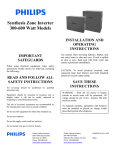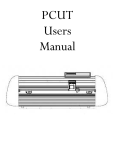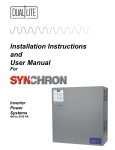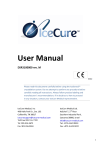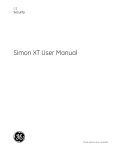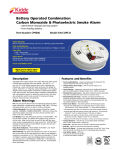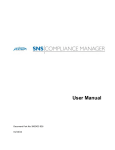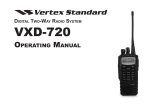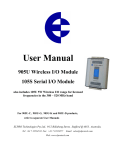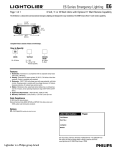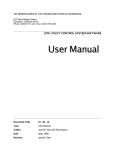Download ELI-S-400 120 Volt
Transcript
ELI-S-400 120 Volt ELI SERIES EMERGENCY LIGHTING INVERTERS Installation and Operation Instructions ! IMPORTANT SAFEGUARDS ! WHEN USING ELECTRICAL EQUIPMENT, BASIC SAFETY PRECAUTIONS SHOULD ALWAYS BE FOLLOWED, INCLUDING THE FOLLOWING: READ AND FOLLOW ALL SAFETY INSTRUCTIONS 1. 2. 3. 4. 5. 6. 7. 8. All servicing should be performed by qualified personnel only. Equipment should be mounted in locations and at heights where it will not be readily subjected to tampering by unauthorized personnel. The use of accessory equipment not recommended by the manufacturer may cause an unsafe condition. Do not use this equipment for other than intended use. Do not use outdoors. Do not let supply cords touch hot surfaces. Do not mount near gas or electric heaters. Use caution when servicing batteries. Battery acid can cause burns to skin and eyes. If acid is spilled on skin or eyes, flush acid with fresh water and contact a physician immediately. SAVE THESE INSTRUCTIONS CAUTION: TO AVOID ELECTRICAL OVERLOAD, TOTAL CONNECTED LAMP LOAD (FACTORY AND FIELD INSTALLED) SHOULD NOT EXCEED OUTPUT RATING. SERVICE BY QUALIFIED PERSONNEL ONLY WARNING – Shut off AC power to branch circuits to which units will be connected. All wiring should be per N.E.C. Articles 501-4(b) and local codes. To maintain warranty, equipment with batteries must be installed or placed on charge within prescribed period after shipment. 11/02/15 © Philips Emergency Lighting 236 Mt. Pleasant Rd. • Collierville, TN USA 38017-2752 • Tech Support 888-263-4638 • Fax 901-853-5009 • www.philips.com/bodine 70100264 Table of Contents Section 100 System Installation Instructions Description Page 101. Unit Specifications . . . . . . . . . . . . . . . . . . . . . . . . . . . . . . . . . . . . . . . . . . . . . . . . . . . . . . . . . . 3 102. Receiving, Moving and Storing Systems and Batteries . . . . . . . . . . . . . . . . . . . . . . . . . . . . . . . . . . . . . . . . . 4 102.1 Shipping Damage . . . . . . . . . . . . . . . . . . . . . . . . . . . . . . . . . . . . . . . . . . . . . . . . . . . . 4 102.2 Temporary Storage of Units and Batteries. . . . . . . . . . . . . . . . . . . . . . . . . . . . . . . . . . 4 103. Installation Requirements . . . . . . . . . . . . . . . . . . . . . . . . . . . . . . . . . . . . . . . . . . . . . . . . . . . 4 103.1 Operating Environment . . . . . . . . . . . . . . . . . . . . . . . . . . . . . . . . . . . . . . . . . . . . . . . 4 103.2 High Altitude Operation . . . . . . . . . . . . . . . . . . . . . . . . . . . . . . . . . . . . . . . . . . . . . . 4 104. Cabinet Mounting . . . . . . . . . . . . . . . . . . . . . . . . . . . . . . . . . . . . . . . . . . . . . . . . . . . . . . . . . . 5 104.1 Tools Required . . . . . . . . . . . . . . . . . . . . . . . . . . . . . . . . . . . . . . . . . . . . . . . . . . . . . . 5 104.2 Mounting Hardware . . . . . . . . . . . . . . . . . . . . . . . . . . . . . . . . . . . . . . . . . . . . . . . . . . 5 104.3 Cabinet Clearance . . . . . . . . . . . . . . . . . . . . . . . . . . . . . . . . . . . . . . . . . . . . . . . . . . . 5 104.4 Knockout Locations . . . . . . . . . . . . . . . . . . . . . . . . . . . . . . . . . . . . . . . . . . . . . . . . . . 5 104.5 Cabinet Mounting - Models ELI-S-400 (Two Cabinet Unit) . . . . . . . . . . . . . . . . . . . . . . . . 6/7 105. Battery Installation and Connection . . . . . . . . . . . . . . . . . . . . . . . . . . . . . . . . . . . . . . . . . 8 105.1 Tools . . . . . . . . . . . . . . . . . . . . . . . . . . . . . . . . . . . . . . . . . . . . . . . . . . . . . . . . . . . . . 9 105.2 Installation Considerations . . . . . . . . . . . . . . . . . . . . . . . . . . . . . . . . . . . . . . . . . . . . 9 105.3 Battery Installation Procedure . . . . . . . . . . . . . . . . . . . . . . . . . . . . . . . . . . . . . . . . . 9 105.3B Wiring Diagram 3 – . . . . . . . . . . . . . . . . . . . . . . . . . . . . . . . . . . . . . . . . . . . . . . . . . . . . . . . . . . . . . . . . 9 105.4 Electronics Cabinet Voltage Check. . . . . . . . . . . . . . . . . . . . . . . . . . . . . . . . . . . . . . . 9 106. AC Connections . . . . . . . . . . . . . . . . . . . . . . . . . . . . . . . . . . . . . . . . . . . . . . . . . . . . . . . . . . . . . . 9 106.1 AC Wiring Preparations . . . . . . . . . . . . . . . . . . . . . . . . . . . . . . . . . . . . . . . . . . . . . . . 10 106.2 AC Input and AC Output Connections . . . . . . . . . . . . . . . . . . . . . . . . . . . . . . . . . . . . . 10 107. Final Installation Checklist. . . . . . . . . . . . . . . . . . . . . . . . . . . . . . . . . . . . . . . . . . . . . . . . . . . . . 10 108. System Start-Up Procedure . . . . . . . . . . . . . . . . . . . . . . . . . . . . . . . . . . . . . . . . . . . . . . . . . 10/11 109. System Verification . . . . . . . . . . . . . . . . . . . . . . . . . . . . . . . . . . . . . . . . . . . . . . . . . . . . . . . . . 11 Section 200 User Manual Description Page 200. Status Indicators . . . . . . . . . . . . . . . . . . . . . . . . . . . . . . . . . . . . . . . . . . . . . . . . . . . . . . . . . . . 11 Section 300 Maintenance, Warranty and Technical Support Description Page 300. Maintenance . . . . . . . . . . . . . . . . . . . . . . . . . . . . . . . . . . . . . . . . . . . . . . . . . . . . . . . . . . . . . . . 11 300.1 Safe Shut Down Procedure . . . . . . . . . . . . . . . . . . . . . . . . . . . . . . . . . . . . . . . . . . . . . 11 300.2 Routine System Maintenance. . . . . . . . . . . . . . . . . . . . . . . . . . . . . . . . . . . . . . . . . . . 12 300.3 Manual Routine Inverter Tests. . . . . . . . . . . . . . . . . . . . . . . . . . . . . . . . . . . . . . . . . . 12 300.4 Battery Maintenance and Replacement. . . . . . . . . . . . . . . . . . . . . . . . . . . . . . . . . . . . 12 300.5 Routine Battery Inspection and Maintenance. . . . . . . . . . . . . . . . . . . . . . . . . . . . . . . 13 300.6 Battery Replacement Procedure. . . . . . . . . . . . . . . . . . . . . . . . . . . . . . . . . . . . . . . . . 13 300.7 Battery Disposal. . . . . . . . . . . . . . . . . . . . . . . . . . . . . . . . . . . . . . . . . . . . . . . . . . . . . . 13 301. Warranty Information . . . . . . . . . . . . . . . . . . . . . . . . . . . . . . . . . . . . . . . . . . . . . . . . . . . . . . 13 302. Technical Service and Support . . . . . . . . . . . . . . . . . . . . . . . . . . . . . . . . . . . . . . . . . . . . . . . . . . . . . . . . . 13 2 Section 100 System Installation Instructions 101. Specifications Input • Input voltage: 120 VAC. • Input frequency: 60HZ ±2% • Operating temperature: 20ºC to 30ºC (68ºF to 86ºF) • Synchronizing slew rate: 1 Hz per second nominal • Input surge protection: Meets UL 924 Output • Output voltage: 120 VAC, 60HZ. • Output regulation: (static) ±5% based on a 0% - 100% resistive load • Minimum loading: none required • Output distortion: Less than 3% THD linear load • Load power factor: .5 lag to .5 lead • Output frequency: Normally, Synchronized to utility, ±2 Hz during emergency • Overload: 150% for five seconds • Time to transfer to inverter after a utility power failure: <1 ms. Battery • Battery type: Maintenance free sealed lead calcium • Battery charger: Fully automatic with temperature compensation • Recharge time: Meets UL requirements (72 Hours) • Battery protection: Automatic low-battery voltage disconnect and reverse polarity protection. Automatic restart upon utility return • Battery switch: Also used as battery isolator • Standard battery: Sealed lead-calcium: 10-year life • Battery voltage: 72 • Runtimes: 90 minutes. • Operating temperature: 20°C to 30°C (68°F to 86°F) Note: Battery performance rated at 25°C (77°F) TABLE 1 Model Number INPUT/OUTPUT VOLTS ELI-S-400 120 INPUT CURRENT (MAXIMUM) OUTPUT CAPACITY RATING (90 Min.) BATTERY VOLTAGE DIMENSIONS (in) (W x D x H) WEIGHT (Lbs./Kg) 5.8A 400 Watts/440 VA 72 VDC 22 x 8 x 16 132/60.0 3 102. Receiving, Moving and Storing Systems and Batteries 102.1 Shipping Damage Inverter systems and batteries are shipped separately. Carefully inspect all cartons upon receipt for evidence of shipping damage. Notify carrier immediately of leaking or damaged cartons for possible concealed damage. 102.2 Temporary Storage of Units and Batteries For temporary storage of Inverter systems and batteries prior to installation, select a clean, cool, dry location with normal ventilation for human habitation and level floors. Storage Temperature: Store all batteries at 0° to +40°C (32° to +104°F). Batteries will have a longer shelf life if stored at 15°C (60°F). The PFT electronics and battery cabinets may be stored at -20° to +60°C (-4° to+140°F). IMPORTANT: Lengthy storage of batteries will cause irreversible damage to the cells. Failure to connect Inverter system batteries to an energized charging circuit within 90 days from the date of shipment will void the battery warranty. DANGER: Explosive - Can Cause Blindness or Other Severe Injuries Every type of battery can produce hydrogen gas, even sealed, maintenance-free batteries. The gas is vented through the vent caps and into the air. Do not allow smoking, sparks, or flames in battery storage location because hydrogen is concentrated under the vent cap of each cell of the battery. Hydrogen is highly explosive, and is hard to detect because it is colorless, odorless, and lighter than air. 103. Installation Requirements 103.1 Operating Environment Install the Inverter system in a clean, cool, dry place with normal ventilation for human habitation and in such a location to hamper vandalism but allow easy access for testing and maintenance. Operating Temperature: Inverter systems are UL Listed for 20° to 30°C (+ 68° to +86°F) operation. Battery performance and service life is maximized if the operating temperature is maintained at 25°C (77°F). Temperature Effect On Battery Performance: Batteries will be less efficient at temperatures below 18°C (65°F), and high temperatures will reduce battery life. Typically, at 35° C (95° F), battery life will be half of what it would be at normal temperature of 25°C (77°F). At 45° (113°F), battery life will be one-fourth of normal. Ventilation: The air around the unit must be clean, dust-free, and free of corrosive chemicals or other contaminants. Do not place the Inverter system or batteries in a sealed room or container. CAUTION: Never Install Batteries in a Sealed Room or Enclosure 103.2 High Altitude Operation: The maximum operating temperature drops 1°C per 300 meters (2°F per 1000 feet) above sea level. Maximum elevation is 3000 meters (10,000 feet). 4 104. Cabinet Mounting 104.1 Tools Required The following tools are required to install the system: Socket Set, Phillips Screwdriver, Diagonal Wire Cutters, Long Nose Pliers, Electrical Tape, Digital Volt-Ohm Meter, Safety Glasses with Side Shields, Small Punch (K.O. removal), Hammer, Electric Drill, Wood or Masonry Bits, Level. 104.2 Mounting Hardware Mounting hardware is not provided. Care should be taken when selecting mounting hardware to assure that it is the proper type for the application and sized to safely support the systems full weight when installed assuring safe and secure attachment of system to wall surface. For ease of installation, the factory recommends that the head size of mounting screws or bolts be small enough to pass through the keyhole K.O.s provided for mounting. This will allow the unit to be hung on partially installed mounting hardware and facilitate easy cabinet removal if ever necessary. 104.3 Cabinet Clearance IMPORTANT: When mounted, the unit requires a minimum of 8 inches (20.3 cm) of clearance on both the right and left hand sides of the cabinet to assure proper ventilation. 104.4 Knockout Locations All models provide knockouts on the top and left-hand side of the unit. See Fig. 1. Additional entry points, if required can be added using a metal punch. Do not drill into the cabinet as metal filings can cause short circuits and damage the equipment. NOTE: Consider unit knockout locations prior to mounting unit. Allow room for easy routing of conduit to entry point. Fig. 1 1.5” (3.8 cm) 1.5” (3.8 cm) 1.25” (3.18 cm) Left Side of Cabinet 1.25” (3.18 cm) 1.5” (3.8 cm) 1.5” (3.8 cm) 0.875” (2.2 cm) Diameter K.O. TYP (4) Top of Cabinet NOTE: Units are designed for left hand conduit entry only. No K.O.s provided on right hand top or side of cabinet. 5 104.5 Cabinet Mounting - ELI-S-400 All models are designed for wall mounting. The cabinets have 4 keyhole slots for easy mounting and removal, make sure that the surface the system is fastened to, and the fasteners used are capable of safely supporting the weight of the unit. 1. Select area for unit mounting. When installed, cabinet must have a minimum of 8” (20.3 cm) of clearance on both the right and left hand side of the cabinet to assure proper ventilation. Conduit entry should be from the top left or left hand side of cabinet. 2. Carefully locate and mark mounting holes on the wall surface using the dimensions shown in Fig. 2 below taking care to assure installed cabinet will be level when hung on mounting hardware. Fig. 2 2.0” (5.08 cm) 18.0” (45.7 cm) 1.0” (2.54 cm) 0.625” (1.6 cm) Keyhole K.O. TYP (4) Back of Cabinet 13.5” (34.3 cm) 3. Drill mounting holes in the wall surface. Partially install mounting hardware such that the heads of mounting screws or bolts project approximately 1/2” (1.3 cm) from wall surface. Hang system cabinet on partially installed hardware and tighten cabinet securely to the wall surface. 4. Once the cabinet is securely fastened to the wall, run and attach conduit using the provided K.O.s on the top or left-hand side of the unit. See Fig. 1. Additional entry points, if required can be added using a metal punch. Do not drill into the cabinet as metal filings can cause short circuits and damage the equipment. Be sure to follow all federal, state, and local codes as it pertains to emergency circuit raceways. Refer to section 106 in this manual for AC wiring information. 6 105. Battery Installation and Connection Important Safety Precautions The installer must take these precautions: 1. Wear protective clothing, eye-wear, rubber gloves and boots. Batteries contain corrosive acids or caustic alkalis and toxic materials and can rupture or leak if mistreated. Remove rings and metal wristwatches or other metal objects and jewelry. Don’t carry metal objects in pockets where the objects can fall onto the batteries or into the Inverter system. 2. Tools must have insulated handles so that they will not short battery terminals. Do not allow a tool to short a battery terminal to another battery terminal or to the cabinet at any time. Do not lay tools or metal parts on top of the batteries, and do not lay any objects where they could fall on to the batteries or into the cabinet. 3. Install the batteries as shown on the battery wiring diagram provided in this manual or with the battery cable kit. When connecting cables, never allow a cable to short across a battery’s terminals, the string of batteries or to the cabinet. 4. Align the cables on the battery terminals so that the cable lug will not contact any part of the cabinet even if the battery is moved. Keep the cable away from any sharp metal edges. 5. Install the battery cables so they cannot be pinched by the Inverter system cover/door. 6. Where conductors may be exposed to physical damage, protect conductors in accordance with NEC requirements. 7. Full voltage and current are always present at the battery terminals. The batteries used in this system can produce dangerous voltages, extremely high currents, and possible risk of electric shock. Batteries may cause severe injury if the terminals are shorted together or to ground (earth).Be extremely careful to avoid electric shock and burns caused by contacting battery terminals or shorting terminals during battery installation. Do not touch un-insulated battery terminals. 8. A qualified electrician who is familiar with battery systems and required precautions must install and service the batteries. Any battery used with this unit shall comply with the applicable requirements for batteries in the standard for emergency lighting and power equipment, UL 924. Cabinets are designed to be used with, and batteries must be replaced by identical cells or a Philips Emergency Lighting approved equivalent. If using substitute batteries not supplied by Philips Emergency Lighting, the unit’s UL listing will be void, and the equipment may failto perform properly. The installation must conform to national and local codes as well. Keep unauthorized personnel away from batteries. 7 105.1 Tools The following tools are required to install the system batteries: Socket Set, Phillips Screwdriver, Electrical Tape, Digital Volt-Ohm Meter, Safety Glasses with Side Shields CAUTION: Always use insulated tools for battery installation. 105.2 Installation Considerations This section explains how to install the Inverter system's batterys, fuses, and cables. A qualified electrician who is familiar with battery installations and applicable building and electrical codes should install the batteries. MAKE SURE THE DC BREAKER IS IN THE OFF POSITION BEFORE PROCEEDING The DC fuse (F1) is shipped instilled from the factory and is located in the fuse block holder in the front of the unit. 105.3 Battery Installation Procedure Battery Voltage: Select which diagram to use from this table: System Model ELI-S-400 System DC Voltage 72 Battery Part Number 1000010228 Number of Batteries 6 Wiring Diagram 1 IMPORTANT: Be careful to observe correct polarity on the battery terminals. Illustrations are given as a guide only, polarity marking may vary from battery to battery. 105.3A WIRING DIAGRAM 1 - ELI-S-400 72 volt Battery Connection Diagram For ease of assembly install the rear intercell connectors between battery sets outside of the unit enclosure. Place each of the three interconnected sets of batteries into the enclosure separately. Do not attempt to place all six batteries into enclosure at once. Intercell Connectors Black Battery Lead Red Battery Lead NOTE: Top of Batteries Shown IMPORTANT: Use only Philips Emergency Lighting supplied batteries to assure proper operation and maintain system warranty. DO NOT TURN ON THE DC BREAKER AT THIS TIME AS SIGNIFICANT DAMAGE TO THE SYSTEM MAY OCCUR (See Section 108 for proper system start-up procedure) 8 105.4 Electronics Cabinet Voltage Check Using a digital volt-ohm meter, check for correct nominal battery voltage between electronics cabinet DC Input NEG and POS wires. Refer to table in section 105.3 for proper system DC voltage. Voltage reading should be ±10% of system DC voltage. 106. AC Connections CAUTION: a. b. c. d. e. All Inverter system units contain hazardous AC and DC voltages. Because of these voltages, a qualified electrician must install the Inverter system, AC line service, and batteries. The electrician must install the AC line service according to local, state and NEC codes and must be familiar with batteries and battery installation. Before installing, maintaining, or servicing the unit, always remove or shut off all sources of AC and DC power and shut off the Inverter system. Disconnect AC line input at the service panel and turn off the Main DC Switch and the Main AC Switch to make sure the unit will not supply output voltage. Whenever AC and/or DC voltage is applied, there will be AC voltage inside the Inverter system unit; the unit can supply power from AC line or from its batteries. To avoid equipment damage or personal injury, always assume that there may be voltage inside the Inverter system. Remove rings, watches, and other jewelry before installing the AC wiring. Always wear protective clothing and eye protection and use insulated tools when working near batteries. Whenever servicing an energized unit with the inside panel open, electric shock is possible; follow all local safety codes. TEST BEFORE TOUCHING! To reduce the risk of fire or electric shock, install the Inverter system and the batteries in a temperature-controlled and humidity-controlled indoor area free of conductive contaminants. See Section 103 for operating environment specifications. 106.1 AC Wiring Preparations 1. 2. 3. 4. 5. 6. Remove the system's front cover. Make sure all breakers are in the off position. Make sure the Inverter system input and output voltages are correct for the particular application. Remember that the Inverter system provides single-phase power only. The input circuit breaker in the input service panel provides the means for disconnecting AC to the Inverter system. Only authorized persons shall be able to disconnect AC to the unit. (See NEC 700-20 and 700-21.) CAUTION: To prevent electrical shock or equipment damage, for all units, the Main AC Switch, the Main DC Switch, all output circuit breakers, and the AC input at the service panel are all off before making AC connections to the Inverter system. If not previously done, remove knockouts for AC Input and AC Output in the top or left side of the Inverter system (See Fig. 1 in Section 104.4). CAUTION: Do not drill the cabinet; drill filings may damage the unit and prevent it from operating. If larger knockouts are needed, use a chassis punch to enlarge the appropriate knockout. Do not add additional or unnecessary knockouts. Install the input and output conduits. Run the AC Input service conductors and AC Output conductors through separate conduits. Inverter system emergency output circuits shall be installed in dedicated conduit systems and not shared with other electrical circuits as described in NEC 700-9(b). 106.2 AC Input and AC Output Connections Make all AC input and output connections to the Inverter system as indicated on the labels within the cabinet. Fig. 6 Terminal Block 1 Circuit Breaker Access Door Installer Connections Building Ground Line In LED Sta tu Indicato s r Panel Neutral In Load 1 Neutral Out Load 1 Line Out AC Output Breaker 1 9 107. Final Installation Checklist IMPORTANT: Before proceeding to the System Start-Up Procedure (Section 108) complete the Final Installation Checklist below. 1. 2. 3. 4. 5. 6. 7. Insure the Inverter cabinet(s) is securely fastened to a wall or other structure. Insure that the input circuit breakers in the building service panel serving as the AC disconnect to the Inverter system is in the OFF position. Check for proper ground connections in the Inverter electronics module cabinet. Check for any loose wiring connections in the Inverter electronics module cabinet. Check that correct nominal battery voltage (72 VDC) is present in the Inverter cabinet between the DC Input NEG and POS. Refer to Section 105.3 for proper system DC voltage. Ensure that the DC Input and AC Input and any optional AC Output breakers are in the OFF position. Verify AC Input voltage to unit matches system voltage configuration. 108. System Start-Up Procedure IMPORTANT: The Inverter system is a sophisticated electronic backup power supply. Care must be taken to follow the steps below in their exact sequence. Failure to do so will result in erroneous alarm messages and possible equipment failure. CAUTION: Familiarize yourself with the shut down procedure in section 300.1 before proceeding with the Start Up. 1.Make sure the front cover/door is installed and secured shut. 2.Turn on the input circuit breaker in the building service panel serving as the AC disconnect to the Inverter system. 3.Open the front access panel so that the input/output circuit breakers within the Inverter unit are accessible. 4.Hold the Pre-charge Switch in the “ON” position for 30 seconds. 5.Release the Pre-charge Switch and immediately turn on the DC input breaker. 6.Turn on the AC input breaker as well as any optional AC Output circuit breaker(s) if supplied. 7.After approximately five seconds, the system should turn on, the lighting loads should be energized, the front panel's green “AC-ON” and “OUTPUT VOLTAGE” LEDs should illuminate. The "OUTPUT CURRENT LED" will illuminate only if the emergency lighting fixtures are connected and operable. 109. System Verification At this point, the connected load should be energized and LED 1, 2, and 3 on the unit’s status indicator panel should be lit. Depending on the state of charge of the batteries the inverter may or may not come on when the test switch is depressed. Allow a 24 hour charge period before testing the inverter system. If you need assistance, call To simulate a power failure, simply press and hold the test switch for a momentary test, or open the AC input circuit breaker for a prolonged test. The inverter will begin operating, the "AC ON" LED will go off, the "OUTPUT VOLTAGE" and “OUTPUT CURRENT” LEDs will remain lit and the “INVERTER ON” LED will illuminate. All connected loads should be energized and operational, HID fixtures should not “wink-out". Allow the inverter to run for several minutes or until satisfied with its operation. Close the AC input breaker to end the test and return the unit to standby mode. Note: It will take a few seconds for the unit to stabilize and return to standby mode 200. LED Status Indicators The Inverter system is equipped with 5 LED indicators showing the operating mode of the inverter, and also to alert you of any possible abnormal conditions. The ON/OFF status of the LEDs will indicate a very specific condition. The following table is used to illustrate as to what these conditions may be: AC-ON LED1 (Green) OUTPUT VOLTAGE LED2 (Green) OUTPUT CURRENT LED3 (Green) INVERTER ON LED4 (Amber) OVERLOAD/SHUTDOWN LED5 (RED) ON AC Input Power Available To Unit Output Voltage Available Load Connected and Operating Inverter Operating (Emergency Mode) Overload Condition OFF No AC Input Power To Unit Output Voltage Failure Load Not Connected or Switched Off Inverter Off (Standby Mode) Normal Operation Should an abnormal condition be detected, contact Philips Emergency Lighting Technical Support at 888-263-4638 for assistance. Do not attempt to make any repairs yourself, the system is fed from more than one power source and extreme care must be taken before servicing. 10 300. Maintenance 300.1 Safe Shut Down Procedure CAUTION: To avoid possible equipment damage or personal injury, assume that there is AC voltage present inside the Inverter system unit any time AC input power or DC battery voltage is applied. The inverter is capable of providing output voltage from the batteries even when there is no AC input line voltage. When AC input voltage is present, the unit can provide output voltage even when the batteries are disconnected. AC AND DC VOLTAGES WILL BE PRESENT INSIDE THE UNIT UNTIL LINE AC ISDISCONNECTED AND ALL INTERNAL SWITCHES ARE TURNED OFF. Final Shut Down Procedure 1. Open the unit’s front access panel. 2. Turn off the DC Input breaker first and then the AC Input breaker. Also turn off all optional AC Output circuit breakers if supplied. CAUTION: HAZARDOUS ENERGY IS STORED IN CAPACITORS INSIDE THE INVERTER UNIT. AFTER TURNING OFF SWITCHES, ALLOW 5 MINUTES FOR CAPACITORS TO DISCHARGE BEFORE ATTEMPTING ANY SERVICE PROCEDURES. 3. If the service technician does not need to access the inside of the unit, keep the unit's front cover/door closed. 4. If the unit will be shut off for an extended period of time, recharge batteries every 60 to 90 days. CAUTION: The batteries will be damaged and the warranty voided if not routinely recharged. NOTE: To turn power back on, follow the “System Start-up Procedure” outlined in Section 108. Be sure to complete all of the steps to as sure the unit will operate properly. 300.2 Routine System Maintenance The Inverter unit is designed to provide years of trouble-free operation. The unit does require some routine attention to assure peak performance. Philips Emergency Lighting recommends a Preventative Maintenance check be performed by a qualified service technician at least every six months. The technician must observe important safety precautions while performing the following recommended tasks: • Inspect and clean the unit interiors • Inspect all batteries for leaks, case swelling or terminal corrosion • Perform an emergency operation test to check operation of all critical connected loads 300.3 Manual Routine Inverter Tests NFPA101 requires that Emergency Lighting Equipment be tested on a monthly basis for a period of at least 5 seconds, and a minimum of 90 minutes once a year. We strongly recommend these guide-lines be followed to insure system readiness, and to prolong battery life. The Inverter system was designed with a front panel test switch to facilitate monthly testing. Simply depress the button and hold to test the inverter at anytime. Once released, the Inverter will revert back to standby operation; this may take a few seconds to allow the unit to synchronize back to the line. For annual 90-minute discharge or other prolonged tests, simply turn off the AC Input breaker. 11 300.4 Battery Maintenance and Replacement This section provides precautions for qualified service personnel working with unit batteries. Important Safety Precautions The service technician must take these precautions: 1. Wear protective clothing, eye-wear, rubber gloves and boots. Batteries contain corrosive acids or caustic alkalis and toxic materials and can rupture or leak if mistreated. Remove rings and metal wristwatches or other metal objects and jewelry. Don’t carry metal objects in pockets where the objects can fall onto the batteries or into the Inverter system or battery cabinet. 2. Tools must have insulated handles so that they will not short battery terminals. Do not allow a tool to short a battery terminal to another battery terminal or to the cabinet at any time. Do not lay tools or metal parts on top of the batteries, and do not lay any objects where they could fall onto the batteries or into the cabinet. 3. Install the batteries as shown on the battery wiring diagram provided in this manual or with the battery cable kit. When connecting cables, never allow a cable to short across a battery’s terminals, the string of batteries, or to the cabinet. 4. Align the cables on the battery terminals so that the cable lug will not contact any part of the cabinet even if the battery is moved. Keep the cable away from any sharp metal edges. 5. Install the battery cables so they cannot be pinched by the battery cabinet or the Inverter system cover/doors. 6. Where conductors may be exposed to physical damage, protect conductors in accordance with NEC requirements. 7. If replacing batteries or repairing battery connections, follow the procedure in this manual to shutdown the Inverter system and remove both AC and DC input power. 8. Full voltage and current are always present at the battery terminals. The batteries used in this system can produce dangerous voltages, extremely high currents, and possible risk of electric shock. Batteries may cause severe injury if the terminals are shorted together or to ground (earth). Be extremely careful to avoid electric shock and burns caused by contacting battery terminals or shorting terminals during battery installation. Do not touch un-insulated battery terminals. 9. A qualified electrician who is familiar with battery systems and required precautions must install and service the batteries. Any battery used with this unit shall comply with the applicable requirements for batteries in the standard for emergency lighting and power equipment, UL 924. Cabinets are designed to be used with, and batteries must be replaced by identical cells or a Chloride approved equivalent. If using substitute batteries not supplied by Chloride, the unit’s UL listing will be void, and the equipment may fail to perform properly. The installation must conform to national and local codes as well. Keep unauthorized personnel away from batteries. CAUTION: A battery can present a risk of electrical shock and high short circuit current. Battery replacement should only be performed by qualified service personnel familiar with battery systems. All safety precautions outlined at the beginning of this section must be observed when servicing, maintaining or replacing batteries. 300.5 Routine Battery Inspection and Maintenance Sealed Lead-Calcium Batteries Lead-Calcium cells are the most common type of battery used today in standby equipment. By design it is as maintenance free as a battery can be. It is recommended, however, that some simple steps be taken to increase system life and maximize reliability: • A quarterly visual check of the batteries should be conducted to look for deformities in the cases and terminal corrosion. Any defective batteries should be replaced. All corroded terminals, regard-less how slight, are to be cleaned and retightened at once to prevent failure of the entire battery bank. • Once a year, all battery connections should be checked for tightness and re-tightened if necessary. 300.6 Battery Replacement Procedure WARNING: Always use the same quantity and type of battery as replacements. Substituting batteries not supplied by Philips Emergency Lighting will void the UL listing of the system and may cause equipment failure. To ensure the superior performance of your Inverter system and to maintain proper charger operation, replace spent batteries only with Philips Emergency Lighting cells having the same part number, voltage and ampere-hour rating as the original batteries. 1.Follow the proper shut down procedure as described in Section 300.1. 2.Break down the battery bank beginning with the intercell connectors. These cables tie the batteries installed on the same shelf together. 3.Next remove the inter-tier cables. These cables connect the batteries located on different shelves together. 4.Remove the batteries from the cabinet. Batteries can be very heavy, use proper lifting methods when removing battery. 5.Install new batteries following the instructions outlined in Section 105.3. 300.7 Battery Disposal WARNING: Do not dispose of batteries in a fire, the batteries could explode.Do not open or mutilate batteries. Released electrolyte is highly toxic and harmful to the skin and eyes. CAUTION: Batteries contain lead. Many state and local governments have regulations about used battery disposal. Please dispose of the batteries properly. For assistance, contact Philips Emergency Lighting Technical Support at 888-263-4638 during normal business hours (EST). 12 301. Warranty Information IMPORTANT: Lengthy storage of batteries will cause irreversible damage to the cells. Failure to connect Inverter system batteries to an energized charging circuit within 90 days from the date of shipment will void the battery warranty. WARRANTY: The system is guaranteed, under normal and proper use, against defects in workmanship and materials for a period of 3 years from the date of shipment. Batteries supplied as part of the system are covered under a separate pro-rata warranty as described below: Batteries - 1 year plus 9 years pro-rata period 302. Technical Service and Support During or after installation, Technical Support is available to provide expert assistance. Our service representatives are available to answer customers’ questions or solve their problems. Toll-Free Number A toll-free phone has been set up for Inverter technical assistance. The number is: 888-263-4638. Service representatives are available during normal working hours (EST). 13













